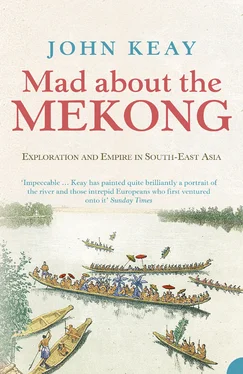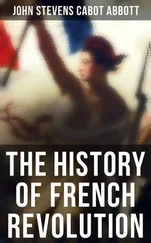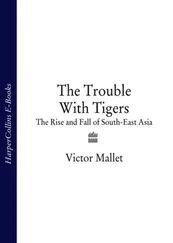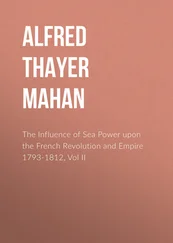To the heavy cases of instruments, preservatives and drawing materials, and to the decidedly generous quantities of flour and biscuit (five hundred kilos) and liquor (766 litres of wine, 302 litres of brandy) was added the wherewithal for defraying expenses. Cash came in gold bars, gold leaf, Mexican silver dollars and Siamese silver ticals to a total value of thirty thousand francs. The trade goods included bolts of velvet, silk and cotton, glass trinkets, an enormous quantity of brass wire and a selection of pistols and rifles. The brass wire was reportedly in great demand upriver, says de Carné; the guns were ‘a purely speculative investment’. At a rough calculation, the total displacement must have been around five tons, a hefty load for a cannonière and way beyond the capacity of most local craft.
Properly speaking, the river at Phnom Penh is the Mekong itself. To the French, though, this particular three-kilometre-wide reach was always Le Quatre-bras. The four arms’, or crossroads, corresponded to the junction of the four rivers: the Mekong itself which comes swinging down from the north, the Hau Tien which exits east, the Hau Giang (Bassac) which exits south, and the Tonle Sap which comes and goes somewhat north by north-west.
Poised on the bank of such a vital confluence, it is curious that Phnom Penh had only just been selected by King Norodom as his capital. Lagrée liked to think it was French protection that had emboldened the king’s move from his less accessible abode at Udong, and certainly the new site could be comfortably commanded by a canonnière’s cannon. Whether this was meant to reassure His Highness or to restrain him was debatable. A new palace was being built on the waterfront (where it still is), and the expedition’s send-off celebrations seem to have doubled as part of the dedication ceremonies. A sweltering evening of speeches, toasts, light refreshments and leaden jokes was cheered, though scarcely enlivened, by the appearance of gold-girt beauties performing the statuesque posturing which is Cambodian classical dance. The Frenchmen lusted dutifully, then fidgeted involuntarily as they melted into their dress uniforms.
Departure came as a relief. As they cast off, the French flag was run up the tiny mast of Lagrée’s canonnière. The other canonnière fired its single gun four times by way of salute, and on the command of a whistle – these things were strictly regulated – the crews cheered in unison ‘ Vive l’Empereur ,’ then, after another blast of the whistle, ‘ Vive le Commandant de Lagrée. ’ It was midday on 7 July 1866. There was no answering salute from the shore. The cheers died on the waters with the finality of what was indeed the last farewell. ‘A few moments later,’ says Garnier, ‘we sailed alone on the vast river.’
‘The highest point previously fixed by the French on the Great Cambodia River [i.e. the Mekong] was Cratieh, about 280 miles from the mouth. Beyond this a long succession of rapids was encountered, occurring in a scarcely inhabited region of splendid forest which separates Laos from Cambodia.’
SIR RODERICK MURCHISON,
President of the Royal Geographical Society, May 1869
ABOVE PHNOM PENH the river is at last the Mekong proper rather than one of its deltaic necks. Low-lying islands of unremarkable verdure clutter the stream and conceal its full extent; in Garnier’s day they were planted with cotton from which King Norodom derived a sizeable tax yield. Beyond them, knee-deep in bamboo fronds and badly in need of a hairbrush, spindly sugar palms reel across the floodplain like pin-men with hangovers. Untroubled and still unconfined, the Mekong wallows, buffalo-brown in a swamp of green, as if reluctant to reveal its majestic proportions in such disrespectful company.
More interesting is the traffic. Smaller, slimmer launches than the Angkor cruisers today swoop upriver to Kratie, bus-stopping at riverside pontoons to offload passengers and take on hardboiled eggs. Sampans and the occasional rustbucket recall the Delta; but both are here upstaged and outpaced by the first pirogues. In October, as the annual water festival in Phnom Penh draws near, pirogues predominate, darting out onto the river like agitated crocodiles. From bays and side creeks, from round the next bend and behind the last island, they nose into midstream, an Oxbridge armada not of rowing eights but of paddling eighties. The climax of the water festival is the boat races, and to that end competitors practise hard and then make their way downriver.
Most waterside villages, and quite a few nowhere near the river itself, participate. Each has its long racing pirogue and each racing pirogue is propelled by anything from twenty to a hundred paddlers ranged along its length in file. Many boats sport flags with their crews attired in identical bandanas, like cadres of some Khmer Rouge water fraternity. Others, clearly scratch outfits, have yet to master a stroke or merit team status. Adding much to the hilarity as well as the hazards, supporters offer abuse and encouragement from an accompanying flotilla of listing workboats and redundant ferries. Nowhere else, and at no other time, is the river so animated. The pirogues, sensationally tapered from hollowed-out tree trunks, skim between the sky above and the sky in the water, prows raised like fabulous sea-serpents.
Steaming upriver in July, with the rains growing heavier by the day, the Mekong Exploration Commission missed this spectacle. But come October they would find themselves at Bassac (now Champassak) in lower Laos and would there witness the same festival with equivalent boat races. Again Delaporte would be vindicated. He duly drew the scene: and but for the spectators, who seem somewhat underdressed and anthropologically over representative, he again took few liberties. Two of his most reproduced prints depict, respectively, the river races in the morning and the fireworks at night. In each there is much, perhaps too much, livestock and vegetation. Would not the pigs have taken their dustbath in the shade, or the elephants have been stampeded by the fireworks? But to carp at this is to nitpick, just like the mother cradling her child in the foreground. Delaporte’s pirogues are superb; profiled against the great white river they are aligned like words in an unknown script, random runes adrift on an empty page.
Kompong Cham, the first port above Phnom Penh, is today notable as the hometown of Prime Minister Hun Sen and as the site of a brand-new bridge. The two things are not unconnected. Kompong Cham roots for Hun Sen and Hun Sen rewards Kompong Cham. The country’s strongman is as locationally linked with its most impressive piece of civil engineering as are the two sides of the river by the bridge. This is, in fact, the only bridge across the Mekong in Cambodia, and as is the way with high-striding spans of gleaming ferro-concrete, it makes the river look misleadingly manageable. Having passed under it with eyes shut, a Mekong-lover may be excused for passing over it in silence.
In the 1860s there were no bridges over the Mekong anywhere, and this remained the case for more than another century. In Chinese Yunnan, where the river is called the Lancang, a rickety Meccano construction reportedly replaced the ferry in the mid-twentieth century; but below that, for over three thousand kilometres, the river was unspanned until 1994. It was as if, in the United States, there were no way to cross the Mississippi south of Minneapolis. The engineering was not the problem. Few rivers so obligingly constrict themselves. Bridges were not built because the traffic which might use them did not exist.
Amongst the world’s major rivers the Mekong, though neither the longest nor the largest, still enjoys the distinction of being the least utilised. No great ports disfigure its shores. Phnom Penh and Vientiane, though national capitals, scarcely qualify as cities; the towns are few and mostly disappointing; and the villages keep their distance, preferring the seclusion of a sidestream or the security of adjacent hill and forest.
Читать дальше












